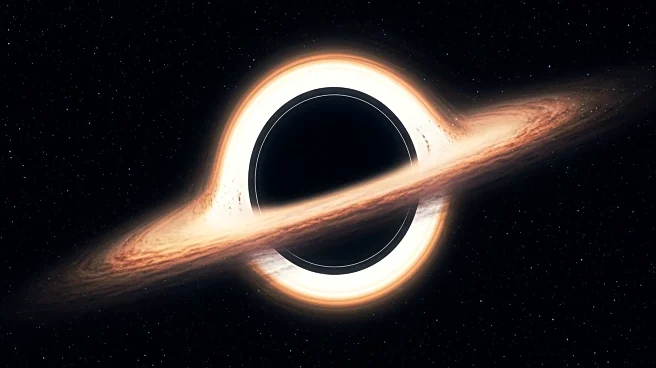What's Happening?
Astronomers have identified a galaxy, CAPERS-LRD-z9, from when the universe was approximately half a billion years old, hosting the most distant known black hole. This discovery was made using the James Webb Space Telescope (JWST), which revealed broad emission lines indicative of gas spiraling around a supermassive black hole. The galaxy's redshift is measured at z = 9.288, marking it as a significant find in understanding black hole growth in the early universe. The black hole is estimated to have a mass between 4.5 and 316 million solar masses, surrounded by a dense shell of dusty gas. This discovery challenges existing theories on how black holes can grow rapidly in such a short cosmic timeframe.
Why It's Important?
The discovery of CAPERS-LRD-z9 provides crucial insights into the formation and growth of black holes in the early universe. Understanding these processes is vital for astrophysics, as it can reshape theories about cosmic evolution and the role of black holes in galaxy formation. The findings suggest that black holes could grow from massive seeds or smaller seeds that accrete matter at super-Eddington rates, which could influence future research and models in cosmology. This discovery also highlights the capabilities of the JWST in exploring distant cosmic phenomena, potentially leading to more groundbreaking discoveries.
What's Next?
Further observations and studies are expected to explore the implications of this discovery on black hole formation theories. Researchers may focus on identifying more 'little red dot' galaxies to understand the prevalence and characteristics of early universe black holes. The findings could prompt new theoretical models and simulations to explain rapid black hole growth. Additionally, the JWST will continue to play a pivotal role in uncovering more distant cosmic objects, enhancing our understanding of the universe's infancy.
Beyond the Headlines
The discovery raises questions about the nature of early universe galaxies and their role in cosmic evolution. It challenges existing paradigms about black hole growth limits and the conditions necessary for their formation. The findings could lead to a reevaluation of the timeline of cosmic events and the processes that shaped the universe's structure.

